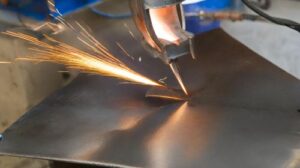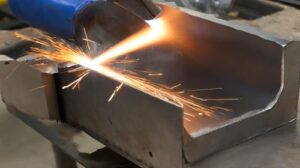Table of Contents
- 1. Beginner Welding Projects: An Overview
- 2. Basic Welding Techniques for Beginners
- 3. List of Easy Welding Projects
- 4. DIY Welding Project Ideas
- 5. Tips for Success in Beginner Welding Projects
- 6. Exploring Advanced Beginner Projects
- 7. Resources for Beginner Welders
- 8. Safety Measures and Precautions for Welding Projects
- 9. Importance of Practice in Welding
- 10. Incorporating Welding in DIY Projects
- 11. Project Maintenance and Durability
- 12. Budget-Friendly Welding Projects
- 13. Environmental Considerations in Welding
- 14. Sharing Your Welding Journey
- Importance of Sharing Projects and Experiences
- Ways to Share Your Welding Experience
- Conclusion
- FAQs
- Is welding difficult for beginners?
- What safety gear is essential for welding?
- Can welding be a hobby?
- Do I need expensive equipment to start welding?
- Are there online resources for learning welding techniques?
Welding is an art form that opens up a world of creativity and hands-on craftsmanship. For beginners, starting with the right projects can make all the difference. Dive into the world of welding with these beginner-friendly projects and tips to set yourself on the path to becoming a skilled welder.
Welding is often perceived as a complex skill reserved for professionals. However, with the proper guidance and projects, even novices can quickly grasp the basics and create impressive metalwork. Here’s a comprehensive guide to beginner welding projects for those eager to embark on this journey.
1. Beginner Welding Projects: An Overview
Importance of Starting with Simple Projects
Considering the intricacies involved, embarking on a welding journey as a beginner might feel overwhelming. However, the adage start small perfectly applies here. Simple welding projects serve as stepping stones into the fascinating world of metalwork.
Building Confidence Through Simplicity
The significance of commencing with straightforward welding projects cannot be overstated. They act as confidence boosters, allowing newcomers to grasp fundamental techniques without feeling intimidated. Crafting a small, uncomplicated piece helps us understand the behavior of metals under heat and the intricacies of joining them together.
Familiarization with Equipment and Techniques
Simple projects provide the ideal platform for acquainting oneself with welding equipment. From understanding the functions of a welding machine to handling welding rods and selecting appropriate safety gear, these initial projects serve as practical learning sessions.
Embracing the Learning Curve
Every beginner faces a learning curve, and simple projects offer a gentle ascending slope. They allow room for trial and error, providing valuable insights into the nuances of welding. Through these experiences, beginners gradually develop an eye for precision, learn to manage heat control, and appreciate the art of welding.
Building a Solid Foundation
Starting with uncomplicated projects lays a sturdy foundation for future endeavors. It’s akin to mastering the ABCs before diving into literature. Each small project serves as a building block, gradually enhancing skills and paving the way for tackling more intricate and challenging welding tasks.
Fostering Passion and Curiosity
Simple projects kindle the passion for welding and spark curiosity. They instill a sense of accomplishment, encouraging beginners to explore further and experiment with different welding techniques and materials. This curiosity becomes the driving force behind continual improvement and innovation.
2. Basic Welding Techniques for Beginners
Explanation of Welding Equipment
Welding encompasses various techniques, each requiring specific equipment. Understanding these tools is fundamental for any beginner:
Welding Machine: The Power Source
The welding machine, often termed a welder or welding power supply, serves as the heart of welding operations. It generates the electric current necessary for creating the arc that melts metals. Beginners typically start with MIG, TIG, or stick welders, each having its unique functionalities and suitable applications.
Protective Gear: Shielding Yourself
Safety is paramount in welding. Protective gear includes welding helmets with auto-darkening filters, safety glasses, welding gloves, flame-resistant clothing, and sturdy boots. These items shield against harmful UV radiation, sparks, heat, and potential debris, ensuring the welder’s safety.
Welding Consumables: Rods, Wire, and Electrodes
Various welding techniques demand different consumables. Welding rods, wires, and electrodes are materials used to create the welds. Beginners should understand the characteristics and applications of each type to choose the suitable consumable for their projects.
Safety Precautions and Guidelines
Ventilation and Workspace Setup
Proper ventilation is crucial when welding to prevent inhaling fumes and gases. Working in a well-ventilated area or using fume extractors reduces health risks. Additionally, organizing a clutter-free workspace with a fire extinguisher readily available ensures a safe working environment.
Understanding Welding Hazards
Welding involves inherent hazards, such as arc flash, electric shock, and potential burns. Beginners should comprehend these risks and follow safety guidelines meticulously. Inspecting equipment, avoiding damp conditions, and keeping flammable materials away from the workspace are critical precautions.
Proper Welding Techniques
Learning the correct welding techniques is essential. Maintaining a consistent arc length, controlling the travel speed, and mastering hand positioning are crucial for achieving strong and clean welds. Regular practice and guidance help in honing these skills.
Emergency Response Plan
Being prepared for emergencies is vital. Knowing how to handle small fires, understanding first aid procedures for burns or injuries, and having emergency contacts readily available are indispensable safety measures.
3. List of Easy Welding Projects
Simple Projects for Practicing Welding Skills
1. Welded Bookends
Creating bookends involves welding two metal pieces together. It’s an ideal project to practice basic welding techniques like tack welding and grinding. These bookends not only serve a functional purpose but also allow for artistic expression through different shapes and designs.
2. Coat Hooks
Crafting coat hooks introduces beginners to welding small, intricate shapes. Welding hooks onto a metal strip or plate enhances skills in welding joints and managing heat control. It’s a practical and rewarding project for organizing spaces while refining welding techniques.
3. Plant Stands
Constructing a simple plant stand involves welding together metal rods or bars. This project enhances skills in measuring, cutting, and welding various pieces together. It offers a practical and decorative outcome, perfect for indoor or outdoor use.
4. Metal Artwork
Creating small metal artworks allows beginners to experiment with artistic welding. This project encourages creativity by welding various metal pieces into unique shapes or patterns. It’s an excellent opportunity to hone precision and explore different welding angles.
Step-by-Step Instructions for Each Project
Materials Required
Each project requires specific materials such as metal rods, sheets, welding rods or wire, a welding machine, safety gear, a grinder, and measuring tools.
Step-by-Step Guide
- Preparation: Gather materials, measure and cut metal pieces as per design.
- Setup: Ensure a well-ventilated workspace with safety gear in place.
- Welding: Practice tack welding to join pieces, ensuring alignment and stability.
- Finishing: Grind rough edges, smooth welds, and polish for a clean finish.
4. DIY Welding Project Ideas
Creative and Practical Welding Projects for Beginners
1. Custom Metal Signs
Designing and welding custom metal signs allows beginners to experiment with lettering, shapes, and welding techniques. It’s an opportunity to personalize spaces or create unique gifts while practicing precision in welding.
2. Garden Trellis
Constructing a garden trellis involves welding together metal rods or bars to create a structure for climbing plants. This project combines functionality with creativity and offers hands-on experience in structural welding.
3. Welded Sculptures
Crafting welded sculptures allows beginners to explore their artistic side. Welding various metal pieces together to create sculptures encourages creativity and improves welding precision and control.
4. Repairing Metal Furniture
Restoring or repairing metal furniture is a practical application of welding skills. Beginners can practice welding joints, patching metal, and finishing techniques while bringing old furniture back to life.
Varieties Including Home Decor, Garden, and Basic Repairs
Home Decor Projects
Projects like custom metal frames for mirrors or welded candle holders allow beginners to add a personalized touch to their homes while refining their welding skills.
Garden Projects
Creating garden art, planters, or simple outdoor furniture provides beginners with projects that enhance outdoor spaces while honing welding abilities.
Basic Repairs
Repairing metal objects around the house, such as fixing a broken gate or patching a metal railing, offers practical experience in welding repairs.
5. Tips for Success in Beginner Welding Projects
Advice on Choosing the Right Materials
- Understanding Metal Properties
Different metals have distinct properties and welding requirements. Beginners should familiarize themselves with metals like steel, aluminum, and stainless steel, understanding their characteristics and suitable welding techniques.
- Starting with a Suitable Thickness
Commencing with moderate metal thickness is advisable for beginners. Thinner metals are prone to warping, while thicker ones demand higher heat, both posing challenges for novices.
Troubleshooting Common Welding Issues
- Managing Heat Control
Controlling heat is critical in welding. Beginners often struggle with overheating or underheating metal, leading to weak welds or distortion. Practice and patience are key to mastering heat control.
- Avoiding Welding Defects
Issues like porosity, spatter, or incomplete fusion are common in welding. Learning to identify and rectify these defects through proper techniques and adjustments is crucial for successful welding.
Additional Tips for Beginners
- Practice Consistently
Regular practice is the cornerstone of improvement in welding. Devote time to welding practice sessions to refine skills and build muscle memory.
- Seeking Guidance and Feedback
Joining welding communities or seeking guidance from experienced welders can provide invaluable insights and feedback to enhance skills and troubleshoot problems.
6. Exploring Advanced Beginner Projects
Next-Level Projects to Advance Welding Skills
1. Metal Artwork with Intricate Designs
Creating more complex metal artwork involves intricate welding techniques and designs. This project challenges beginners to refine their welding precision and experiment with diverse shapes and patterns.
2. Small Structural Fabrications
Undertaking small structural projects like building a basic frame or a simple table requires a deeper understanding of welding joints, measurements, and stability. These projects push beginners towards more structural welding complexities.
3. Simple Metal Repairs or Modifications
Taking on repairs or modifications of metal objects, such as fixing a metal gate or customizing a piece of furniture, allows beginners to apply their growing welding skills in practical scenarios.
Challenges and Growth Opportunities
- Precision and Detailing
Advanced beginner projects demand higher precision and attention to detail. Working on intricate designs or structural elements sharpens welding techniques.
- Problem-Solving Skills
Encountering more complex projects encourages beginners to develop problem-solving abilities. Identifying challenges and finding practical solutions become integral in advancing welding skills.
7. Resources for Beginner Welders
Online Tutorials, Forums, and Communities for Support
- Online Welding Tutorials
Numerous online platforms offer comprehensive tutorials catering to beginners. Websites, YouTube channels, and specialized welding forums provide step-by-step guides, tips, and demonstrations for various welding techniques.
- Interactive Forums and Communities
Engaging with online welding communities allows beginners to seek advice, share experiences, and gain insights from seasoned welders. Platforms like Reddit’s welding subreddit or welding-focused forums foster learning through discussions and shared knowledge.
Recommendations for Further Learning and Skill Improvement
- Welding Workshops and Classes
Seeking local workshops or enrolling in welding classes at community colleges or vocational schools provides hands-on learning experiences under expert guidance, accelerating skill development.
- Books and Manuals
Reference materials like welding handbooks or instructional books offer in-depth knowledge, covering welding theories, techniques, and practical applications, serving as valuable resources for beginners.
8. Safety Measures and Precautions for Welding Projects
Detailed Safety Guidelines for Various Welding Techniques
Personal Protective Equipment (PPE)
Welding requires specific PPE for safety. A welding helmet with a proper auto-darkening filter protects the eyes from harmful UV radiation. Welding gloves, flame-resistant clothing, safety glasses, and sturdy footwear shield against burns, sparks, and metal fragments.
Ventilation and Workspace Setup
Ensure adequate ventilation in the workspace to prevent inhalation of welding fumes and gases. Positioning the welding area away from flammable materials and maintaining a clutter-free workspace is vital. Having a fire extinguisher nearby is a necessary precaution.
Equipment Safety Checks
Regularly inspecting welding equipment is essential. Ensure the welding machine, cables, and electrodes are in good condition. Faulty equipment can lead to hazardous situations, so thorough checks before starting any welding task are imperative.
Importance of Protective Gear and Workspace Setup
Protecting Against Health Hazards
Welding generates harmful fumes, gases, and intense light. Prolonged exposure without proper protection can lead to respiratory issues, skin burns, or eye injuries. Therefore, wearing appropriate PPE mitigates these health risks.
Minimizing Fire Hazards
Welding involves high heat, making fire hazards a significant concern. Ensuring a clear workspace, using fire-resistant materials, and having a fire extinguisher ready significantly reduce the risk of fires.
Proper Handling of Equipment
Knowing how to handle welding equipment safely prevents accidents. Learning correct electrode and gas handling, as well as proper machine operation minimizes risks and ensures a safe working environment.
Of course, there’s the content for the ninth part of the outline:
9. Importance of Practice in Welding
Emphasizing the Significance of Consistent Practice
Developing Muscle Memory and Precision
Regular practice in welding is akin to honing a craft. It allows beginners to develop muscle memory, enhancing hand-eye coordination and precision in handling welding equipment. The more one practices, the more refined their skills become.
Improving Technique and Efficiency
Practice sessions offer opportunities to fine-tune welding techniques. Experimenting with different welding angles, travel speeds, and materials helps in discovering optimal settings and methods, leading to increased efficiency.
How Practice Enhances Skill and Precision
- Consistency Builds Confidence
Consistent practice builds confidence. As beginners see improvement in their welds over time, they become more assured in their abilities, encouraging them to tackle more challenging projects.
- Refinement Through Repetition
Repetitive practice allows for incremental improvements. Each session presents a chance to correct mistakes, refine techniques, and learn from previous experiences, gradually enhancing skills.
10. Incorporating Welding in DIY Projects
Integrating Welding Techniques in Personal Projects
- Utilizing Welding for Custom Creations
Welding can be incorporated into a myriad of do-it-yourself (DIY) projects. Whether it’s constructing a metal frame for furniture, welding brackets for shelves, or crafting decorative pieces, welding adds a unique touch and durability to DIY creations.
- Personalization and Customization
Welding empowers individuals to bring their creative visions to life. By integrating welding techniques, DIY enthusiasts can customize projects to fit specific sizes, shapes, or designs, making their creations truly unique.
Encouraging Creativity and Experimentation
- Exploring New Possibilities
Adding welding to DIY projects encourages experimentation. It opens doors to new possibilities, allowing individuals to explore diverse materials, structures, and designs, fostering a sense of innovation and creativity.
- Combining Skills for Enhanced Projects
Combining welding with other DIY skills, such as woodworking or crafting, enhances the scope of projects. Incorporating welded metal elements into wooden furniture or combining various materials results in aesthetically pleasing and functional pieces.
11. Project Maintenance and Durability
Tips for Ensuring Longevity of Welded Projects
Proper Cleaning and Maintenance
Regular cleaning and upkeep are essential for maintaining welded projects. Removing dirt and debris, and applying appropriate coatings or finishes help prevent corrosion and preserve the project’s appearance.
Addressing Wear and Tear
Over time, welded projects might experience wear or minor damage. Timely repairs, reinforcing weak joints, or repainting areas prone to rusting ensure the longevity of the project.
Factors Influencing Durability
Quality of Materials and Welds
The durability of a welded project heavily depends on the quality of materials used and the welds themselves. Using high-quality materials and executing strong, clean welds significantly contributes to the project’s longevity.
Environmental Considerations
Exposure to different environments impacts the durability of welded projects. Weather-resistant coatings or selecting materials suitable for specific conditions can extend a project’s lifespan.
12. Budget-Friendly Welding Projects
Ideas for Projects Using Cost-Effective Materials
1. Scrap Metal Artwork
Utilizing scrap metal for artistic creations is a cost-effective option. Pieces like sculptures or wall art made from salvaged metal not only reduce expenses but also promote sustainability.
2. Repurposing Old Items
Transforming old or unused items into functional pieces through welding is budget-friendly. Projects like repurposing metal barrels into furniture or creating planters from discarded metal objects offer both creativity and affordability.
Saving Money While Learning and Practicing Welding
Sourcing Affordable Materials
Seeking discounted or surplus metals from scrapyards or metal shops can significantly reduce material costs. Reusing materials or repurposing items also cuts down on expenses.
Starting with Small-Scale Projects
Commencing with smaller projects minimizes material requirements and costs. Simple projects allow beginners to practice welding skills without investing heavily in materials.
13. Environmental Considerations in Welding
Discussion on Eco-Friendly Welding Practices
- Minimizing Environmental Impact
Welding, while a valuable skill, can have environmental implications. Adopting eco-friendly practices such as reducing waste, using environmentally friendly materials, and minimizing energy consumption during welding operations helps mitigate the impact.
- Utilizing Sustainable Materials
Opting for recycled or sustainably sourced metals reduces the environmental footprint of welding projects. Using materials that can be easily recycled or repurposed at the end of a project promotes sustainability.
Minimizing Fumes and Emissions
- Proper Ventilation and Fume Extraction
Ensuring adequate ventilation and employing fume extraction systems effectively reduces the release of harmful fumes and gases into the environment, safeguarding both the welder and the surroundings.
- Choosing Low-Impact Techniques
Adopting welding techniques that generate fewer emissions or utilizing processes that minimize heat input and energy consumption contributes to reducing the environmental impact of welding.
14. Sharing Your Welding Journey
Importance of Sharing Projects and Experiences
- Inspiring Others
Sharing your welding projects and experiences can inspire others to explore the craft. Whether through social media, blogs, or community workshops, showcasing your journey encourages others to delve into welding and discover their creative potential.
- Building a Community
Engaging with fellow welders and DIY enthusiasts fosters a sense of community. Sharing insights, tips, and experiences creates a supportive environment where individuals can learn from each other and grow collectively.
Social Media Platforms
Platforms like Instagram, Facebook, or YouTube offer avenues to share your welding projects. Posting images, videos, or tutorials showcases your work and connects you with like-minded individuals.
Workshops and Community Events
Participating in or hosting workshops and community events allows for hands-on sharing. Interacting with others, demonstrating techniques, and sharing personal experiences contribute to a rich knowledge exchange.
Conclusion
Embarking on a journey into welding as a beginner is an exciting endeavor that opens doors to creativity, craftsmanship, and skill development. Starting with simple projects lays the groundwork for understanding welding techniques, equipment, and safety measures.
Throughout this comprehensive guide, we’ve explored various facets of beginner welding projects. From basic techniques to advanced endeavors, the importance of practice, safety precautions, and sustainability considerations—all contribute to a holistic understanding of welding.
Remember, welding is not just about melting metal; it’s about precision, innovation, and personal expression. As you progress in your welding journey, continually seek knowledge, experiment, and share your experiences with others.
Whether you’re crafting practical items, creating artistic pieces, or delving into DIY projects, embrace the joy of welding. Let each spark from the welding torch ignite your passion and creativity, and may your welded creations stand as a testament to your dedication and craftsmanship.
So, go ahead, pick up that welding mask, grab your tools, and embark on your journey in the world of welding. Let your imagination soar, and may your welds speak volumes about your artistry and commitment.
FAQs
Is welding difficult for beginners?
While it requires practice, starting with simple projects can ease beginners into the welding process.
What safety gear is essential for welding?
Protective eyewear, gloves, and fire-resistant clothing are crucial for welding safety.
Can welding be a hobby?
Absolutely! Welding can turn into a rewarding and enjoyable hobby for many.
Do I need expensive equipment to start welding?
Basic welding equipment is sufficient for beginners; you can invest in higher-end tools as you progress.
Are there online resources for learning welding techniques?
Yes, there are various online tutorials and courses available to help beginners learn welding techniques.













1 thought on “Beginner Welding Projects”